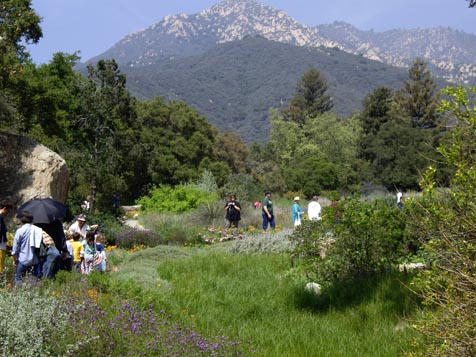Botanic Garden Volunteers on Strike
Fifty-Plus Volunteers Stop Work for One Month to Request Dialogue with Board

On Thursday, in conjunction with National Volunteer Week, the Santa Barbara Botanic Garden hosted its annual volunteer recognition luncheon, complete with speeches, awards, and tasty food. Although usually a celebratory affair full of smiles and applause, yesterday’s event – attended by more than 100 volunteers, staffers, their supervisors, and at least one board member – was overshadowed by the darkness of last week’s layoffs, in which 10 employees of the Botanic Garden were let go due to the nonprofit organization’s financial woes. Some of the more than 100 people who attended said they could not stomach the meal, and others were reportedly suffering from slight fatigue due to the sleeping problems they’d been experiencing over the past week, all because of their concerns for the future of the garden.
Those concerns came to a head at the end of the event, when it was announced that a core group of volunteers would be stopping their unpaid work at the garden for one month, effective immediately, and asked those who supported them to turn in their badges. About 50 did so right away, including the volunteer-of-the-year and three more of the seven people who were given special awards on Thursday. More volunteers – there are about 160 total, but only about half of them are truly active – are expected to join the 30-day strike soon.
The sole goal of the “30-day moratorium,” according to the announcement, is to force the garden’s board of trustees to open a dialogue with the volunteers, who are deeply worried about “ongoing management and financial crises.” By May 23, the volunteers have asked that their new three-person committee – namely Bill Lewis, Carol Weingartner, and Christine Riesenfeld – be presented with “all financial, legal, and administrative documents : including but not limited to financial statements, board minutes, projections, etc.” And at the end of the 30 days, the situation will be “re-evaluated and the Volunteer Activity Moratorium may or may not end.”
Even before the layoffs, the garden relied heavily on volunteers to lead tours, tend the nurseries, conduct garden maintenance, staff the shop, help with the horticultural projects, and more. They work every day of the week, and the garden’s own Web site credits them with 20,000 hours of work annually, which is more than 50 hours of combined work each day. After the cuts last week, some volunteers were informed that the garden would become “even more dependent” on their ranks.
Botanic Garden’s Response
The garden’s remaining staff, who had heard of this possible strike via blogosphere rumors on Tuesday, plans to continue operations as usual. “I just have to say that we’re saddened by the action and that we hope that they will continue to support the garden,” said spokesperson Nancy Johnson. “We will miss their participation and we have a great deal of respect for what they do for the garden.” When asked whether the garden would be able to function without the striking volunteers, Johnson responded, “They will definitely be missed, but the garden will continue to provide the services that we always provide to the public.” Johnson could not speak for what the board of trustees plans to do, but did say, “I’m sure that the trustees have heard their request.”
Johnson relayed that question to the board’s chair, Fife Symington III, the former Republican governor of Arizona who resigned after being convicted for bank fraud in 1997. (His case was appealed, his conviction overturned due to an improper juror dismissal, and he was later pardoned by President Bill Clinton, whom Symington reportedly saved from drowning during their college days.)
Symington, who has addresses in both Phoenix and on East Valley Road, did not answer whether the strike would result in a dialogue with the volunteers, but did explain, “The primary responsibility of the Santa Barbara Botanic Garden’s Board of Trustees is to protect the long-term viability of the garden. As we all know, the current economic environment in the country, and especially in California, is devastating. The garden, like so many other institutions around the country, has been deeply affected by this unprecedented economic downturn. The trustees, with much reluctance and deep sorrow, has had to let some fine people go in order to reach a sustainable level of operation. These actions are never pleasant and do create hardships, but are necessary to protect the institution.”
He continued, “We also deeply appreciate the service provided by our wonderful volunteers and we understand our actions may be upsetting to some, but they nevertheless had to happen. We should all hope for better days.”
Deeper Concerns
While the staff reductions – which affected some employees who had been there more than 30 years and hit the “heart and soul of the garden,” according to one volunteer – may have been the straw that broke the camel’s back. Volunteers and others have had growing concerns for the past couple of years over management of the garden. While no one is denying that the economy’s free fall has hurt the garden’s endowment, an increasing chorus is pointing at increased spending over the past couple years as an irresponsible use of dwindling monies.

Specifically, many objected to the meadow terrace that was being put in place of an old fallen oak tree in an historically protected area. That action was done without notifying many volunteers and even some staff, but was halted by the County of Santa Barbara because of substantial public controversy, followed by a determination that it was in violation of the area’s landmark status. The garden then sued the county for stopping the work (for which it had obtained planning department approval) and it is currently in mediation. On top of that, some volunteers, multiple neighbors, and other garden watchers believe that the organization’s ongoing “Vital Mission Plan” has led to increased costs due to design, legal, and public relations fees.
And then there’s the community backlash over the particular individuals who were laid off. For instance, the firing of Carol Bornstein, who worked at the Garden for 28 years, seems to have hit a particular nerve. One longtime garden watcher whose widely broadcast email eventually reached The Independent said he was “flabbergasted” over that news.
“For those of us interested in California native plants, Carol has been the most respected and important face of the garden for the past 30 years,” explained Randy Baldwin, the general manager of San Marcos Growers’ nursery. “She has been the main person to promote the garden by regularly speaking at symposia, conferences, garden clubs, and other events about the plants that she loves and the garden where she grows them. She has also been instrumental in bringing great speakers, many of them her friends, to speak at the garden, and co-authored (with David Fross and Bart O’Brien) an excellent book about native plants that won the 2006 Book Award from the American Horticultural Society.” He called the decision “incredibly shortsighted.”
Others have emailed The Independent and placed comments throughout the blogosphere that criticized the garden’s higher-ups for not taking more of a cut themselves or developing a better cost-saving scheme to spread out the cash-strapped burden. “It would be helpful to inform the public that none of the upper level execs (Nancy Johnson [vice president of marketing], Ed Schnieder [CEO and president], and Bob Sherwood[vice president of finance]) are taking pay cuts,” wrote one volunteer source in an email. “The main financial problem here is not so much the economic downturn, but the fact that the board has allowed a corporate model to govern a nonprofit structure. Ed Schneider makes over $200,000 a year. Out of his own selfish desire to redefine his position, he has aggressively lobbied against the interests of the rest of the garden staff – and of the garden’s mission, for that matter.” The source added, “I think many of us feel that Ed Schnieder should resign.”
On Wednesday this week, Johnson did say that there were salary reductions for the higher-ups earlier this year. Schneider’s current pay could not be confirmed as of press time, but it seems likely that he continues to pull in a six-figure salary. According to online charity reports, Schneider made $214,724 in 2007 (including his retirement benefits) and garden insiders say he is also provided a house. Combined with the salaries of Johnson and Sherwood, the trio collectively consumed 24 percent of the Garden’s 2007 payroll, which covered the salaries of about 40 total employees.
We Just Want to Talk
But according to volunteers Carol Weingartner and Christine Riesenfeld – who discussed the strike on Thursday over coffee – the strike isn’t about any single issue. In fact, both women have publicly supported elements of the Vital Mission Plan and are in favor of much needed improvements to the Garden. They understand that certain staff positions could have possibly been combined and recognize the need to trim budgets in these tough times.
Rather, the moratorium is strictly a means of opening dialogue with the garden’s board of trustees, which hasn’t had an open meeting in their collective memories. After the now-halted meadow terrace construction, the volunteers actually banded together in February 2008 to request that a volunteer or two be added as non-voting members of the board – that request was flatly denied. They’re hoping to be taken more seriously this time around.
“The community loves this garden,” explained Riesenfeld, a non-practicing intellectual property attorney who is no longer sure what the overall vision for the garden is. “It’s an essential part of the community and we want to make sure it stays a wonderful part of this community.”
Weingartner, a retired radiology oncologist who considers her volunteer work at the garden an integral part of her life, said she is “concerned about the stewardship” but also openly worried about what impact the strike will have on the garden, from kids’ educational programs to plant watering. “We care passionately about the garden,” she said. “We’re there because we love it. We’re willing to be the face of the garden to the public, and we don’t take this lightly.”



